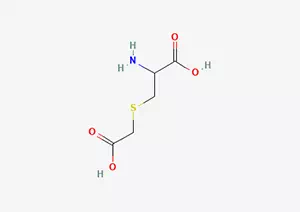All Categories



carbocysteine CAS 2387-59-9, carbocysteine, CAS 2387-59-9
Among the death cases caused by various diseases in various countries, deaths caused by respiratory diseases rank first and show an increasing trend year by year. This severe current situation is closely related to the increasingly deteriorating environment in the process of urbanization.
CAS : 2387-59-9
Formula : C5H9NO4S
Mol. wt. : 179.19
EINECS : 246-934-4
Chemical Name | Carbocysteine |
Other Name | S-Carboxymethyl-L-cysteine; Broncodeterge |
CAS | 2387-59-9 |
EINECS | 246-934-4 |
Type | Pharmaceutical raw materials; Pharmaceutical, pesticide and dye intermediates |
Molecular Formula | C5H9NO4S |
Molecular Weight | 179.19 |

Melting point | 205.5°C |
density | 1.315 (estimate) |
refractive index | 1.5216 (estimate) |
form | solid |
Among the death cases caused by various diseases in various countries, deaths caused by respiratory diseases rank first and show an increasing trend year by year. This severe current situation is closely related to the increasingly deteriorating environment in the process of urbanization. In addition to the damage caused by industrial pollution to the environment, the harmful gases emitted by motor vehicles also seriously threaten people's respiratory health and may even trigger the occurrence and development of other potential diseases, such as pneumonia and chronic pharyngitis.
Respiratory diseases such as chronic bronchitis, bronchiectasis, lung abscess and tuberculosis not only bring great pain to patients, but also pose a challenge to public health security. Therefore, the treatment of these diseases is particularly important. During the treatment process, in addition to appropriate drug therapy for respiratory diseases themselves, applying cough suppressants and expectorants to relieve cough symptoms is also one of the necessary measures.
At present, cough suppressants mainly serve to relieve symptoms. However, to fundamentally solve the problem, it is necessary to start from treating the cause of the cough. Most coughs are caused by excessive release of inflammatory mediators. Conditions such as tracheitis, asthma, pneumonia and lung tumors may all trigger the release of inflammatory mediators. Therefore, during treatment, expectorant drugs can be used as an auxiliary treatment based on the specific condition.
Cysteine or carboxymethyl cysteine, as a polybasic compound containing two carboxyl groups and one amino group, has the effect of thinning sputum. After oral administration, it can increase the secretion of trachea and bronchial glands, making phlegm thinner and easier to cough up. This medicine takes effect quickly and the effect is obvious 4 hours after taking it. However, its production process is relatively complex, involving multiple raw materials and several steps. One of the common synthetic methods is to use cysteine hydrochloride and chloroacetic acid as raw materials and carry out weak carboxylation reactions under alkaline conditions. To achieve this process, it is necessary to configure two-step process equipment for neutralization reaction and carboxylation reaction. In addition, since cysteine hydrochloride is prone to oxidation to cystine after neutralization into a neutral to weakly alkaline solution, the neutralization reaction needs to be carried out at low temperatures and under the protection of nitrogen. Meanwhile, the commonly used processes at present still require two rounds of crystallization and purification to produce qualified products. To sum up, the current technology features complex processes, numerous equipment configurations, and harsh reaction conditions, leading to problems such as difficult rough operation and low yield of finished products. Therefore, it is necessary to develop new production methods to improve this situation.

Detailed Explanation of the Application and pharmacological Effects of Cysteine in the Treatment of Non-suppurative otitis Media in Children
Cysteine, as an important respiratory mucus dissolving agent, has demonstrated its unique therapeutic value in the medical field, especially in the treatment of non-suppurative otitis media in children, where it plays an indispensable role. This medicine can not only effectively relieve the symptoms of otitis media, but also has a certain positive effect on preventing the possible deafness caused by it.
The mechanism of action of cysteine is similar to that of octyl bromide, but it is milder and more targeted. It mainly works by splitting the disulfide bonds of mucoproteins in sputum. This process can significantly reduce the viscosity of sputum, making the originally thick and hard-to-cough sputum thin and easier to be expelled by the patient. Meanwhile, cysteine can also increase the content of mucus fibers in sputum. These fibers act like lubricants, effectively lubricating the inner walls of the bronchi, reducing the adhesion of sputum, and further promoting the discharge of sputum.
More importantly, cysteine is also an efficient mucus regulator. It affects the secretory function of bronchial glands at the cellular level by increasing the secretion of low-viscosity salivary mucin and simultaneously reducing the production of high-viscosity mucin, thereby achieving the purpose of regulating sputum viscosity. This regulatory effect makes phlegm easier to cough up, effectively alleviating problems such as difficult coughing and airway blockage caused by thick phlegm.
Clinically, cysteine is widely used in the treatment of symptoms such as thick phlegm, difficulty in expectoration and phlegm blocking the airway caused by respiratory diseases such as chronic bronchitis and bronchial asthma. For children with non-suppurative otitis media, the use of cysteine not only helps them better drain the fluid in the middle ear and alleviate inflammatory symptoms, but also to a certain extent prevents the occurrence of deafness and protects the hearing health of the children. Therefore, cysteine has significant application value in the treatment of non-suppurative otitis media in children.
* Prompt reply and 24 hours online, professional team to provide best price and high quality product.
* Sample testing support.
* Every batch of products will be tested to ensureits quality.
*The packing also can be according the customers` requirment.
*Any inquiries will be replied within 24 hours.
*we provide Commerical Invoice, Packing List, Bill of loading, COA , Health certificate and Origin certificate. If your markets have any special requirements, let us know.